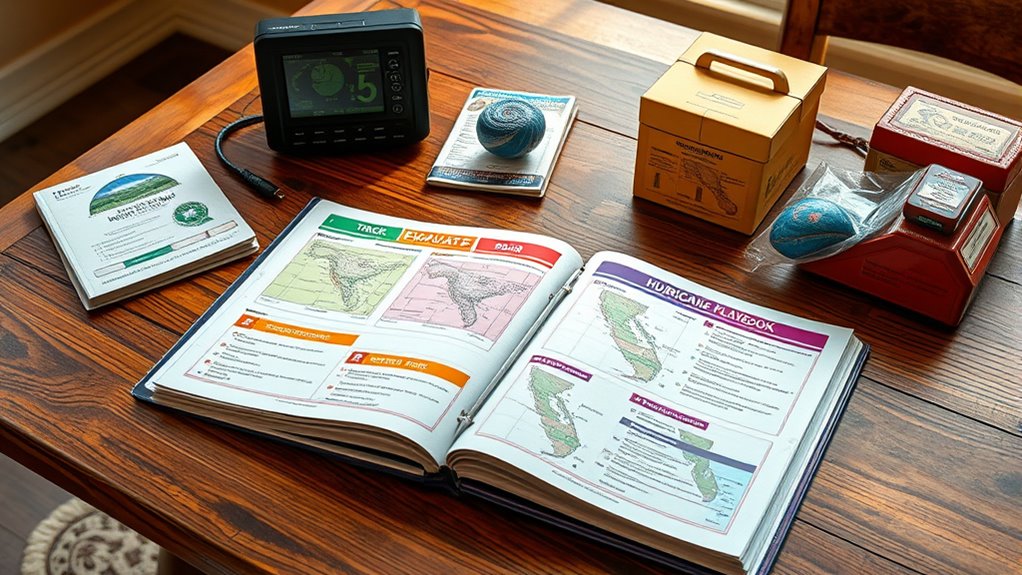To follow a hurricane playbook, start by monitoring weather updates and tracking the storm’s path closely. Prepare your home and supplies early, and know your evacuation routes. When advised to evacuate, do so promptly and safely. During the storm, stay indoors, away from windows, and listen for official guidance. Once it’s safe, assess damages carefully before returning home. Keep learning to stay fully prepared and protect yourself throughout each step.
Key Takeaways
- Monitor official weather updates and storm tracking tools to stay informed of hurricane progress.
- Prepare your emergency kit, secure your home, and plan evacuation routes when warnings are issued.
- Evacuate promptly following local authorities’ instructions, ensuring your vehicle is packed with essentials.
- Stay indoors during the storm, away from windows, and listen to official alerts for safety guidance.
- After the storm, wait for official clearance, then carefully assess damages and document for insurance claims.

Have you ever wondered how to prepare effectively for a hurricane? The key lies in having a solid plan and knowing exactly what steps to take before, during, and after the storm. Your first priority is to stay informed. Keep a close eye on weather updates from reliable sources like the National Hurricane Center or your local weather service. Download emergency alerts on your phone so you receive real-time notifications. Tracking the storm’s path helps you decide when it’s time to act, whether that’s preparing your home or evacuated. As soon as a hurricane warning is issued, start reviewing your plan and gathering supplies. Make sure your emergency kit includes essentials like water, non-perishable food, medications, flashlights, batteries, and important documents. Knowing your evacuation routes in advance can save critical time if you need to leave quickly. Identify multiple routes out of your area, and plan where you’ll go—whether it’s a shelter, a relative’s home, or a designated evacuation center. Having a communication plan with family members also guarantees everyone stays connected. When it’s time to evacuate, do so promptly. Don’t wait until the last minute, as roads can become congested and unsafe. Pack your vehicle with everything you’ll need for at least a few days, including clothes, supplies, and any pet necessities. Remember to lock your home, secure outdoor belongings, and turn off utilities if instructed. Once the storm hits, your focus should shift to safety. Stay indoors, away from windows, and listen to official updates. Avoid using candles—stick with flashlights to prevent fire hazards. If you’re in an evacuation zone, follow the instructions of local authorities and leave as directed. Don’t attempt to go outside or check on property until authorities declare it safe. After the storm passes, your priority becomes evaluating the damage and returning safely. Wait for official clearance before re-entering your home. Be cautious of downed power lines, unstable structures, and flooded areas. When you return, check your home thoroughly for hazards and document damages for insurance claims. Keep in mind that returning isn’t always straightforward; some roads or areas might still be inaccessible. Be patient and cautious. Remember, preparation, timely evacuation, and safety precautions are your best tools to weather a hurricane. Staying calm and following your plan can make all the difference in protecting yourself and your loved ones. The hurricane playbook isn’t just a document—it’s a critical strategy that can help you navigate one of nature’s most powerful storms with confidence. Additionally, understanding storm tracking can improve your preparedness by allowing you to anticipate the storm’s trajectory more accurately.
Frequently Asked Questions
How Early Should I Start Preparing for a Hurricane?
You should start preparing for a hurricane as soon as there’s a forecast indicating a potential threat, ideally 48 to 72 hours before landfall. Gather emergency supplies, secure your home, and create an evacuation plan early. Don’t wait until the storm is close; early preparation guarantees you have enough time to stay safe and avoid last-minute stress. Being proactive can make all the difference in protecting yourself and your loved ones.
What Items Are Essential for a Hurricane Emergency Kit?
You should include essentials like non-perishable food, water (at least a three-day supply), and a first aid kit. Pack necessary medications, flashlights, batteries, and a portable phone charger. Don’t forget personal hygiene items, important documents in a waterproof container, and cash. Also, include blankets, clothing, and supplies for pets if needed. Prepare these items in advance to make certain you’re ready when a hurricane strikes.
How Do I Find Safe Evacuation Routes in My Area?
You can find safe evacuation routes by checking your local government’s website or emergency management agency’s maps. Look for designated evacuation zones and routes, and pay attention to real-time updates on traffic or road closures. Use your GPS or navigation apps to get the latest info, and have a printed map as backup. Plan your route in advance, considering multiple options, so you’re prepared when an emergency strikes.
What Should I Do if I Lose Power During a Hurricane?
You lose power during a hurricane, stay calm and take immediate action. First, use flashlights or battery-powered lanterns—avoid candles to prevent fire hazards. Keep your refrigerator and freezer closed to preserve food, and unplug sensitive electronics to prevent damage. Have an emergency kit ready with essentials like water, snacks, and batteries. Stay informed through a battery-powered radio or mobile alerts, and remember, safety always comes first.
When Is It Safe to Return Home After a Hurricane?
You should wait until local authorities declare it’s safe to return home after a hurricane. Check for official updates on road conditions, flooding, and structural damage before heading back. Avoid entering your property until it’s been inspected by professionals. Use caution and be prepared for possible hazards like downed power lines or flooded areas. Once authorities give the all-clear, you can safely return and begin evaluating any damage.
Conclusion
Remember, just like Odysseus steering treacherous seas, your preparation keeps you steady amid the storm’s chaos. By tracking, boarding, evacuating, and returning with purpose, you become the captain of your fate. The hurricane’s fury may roar like a beast, but your readiness is the lighthouse guiding you home. Stay vigilant, stay safe—trust in your plan, and you’ll weather the tempest with resilience and hope shining through the darkest skies.










